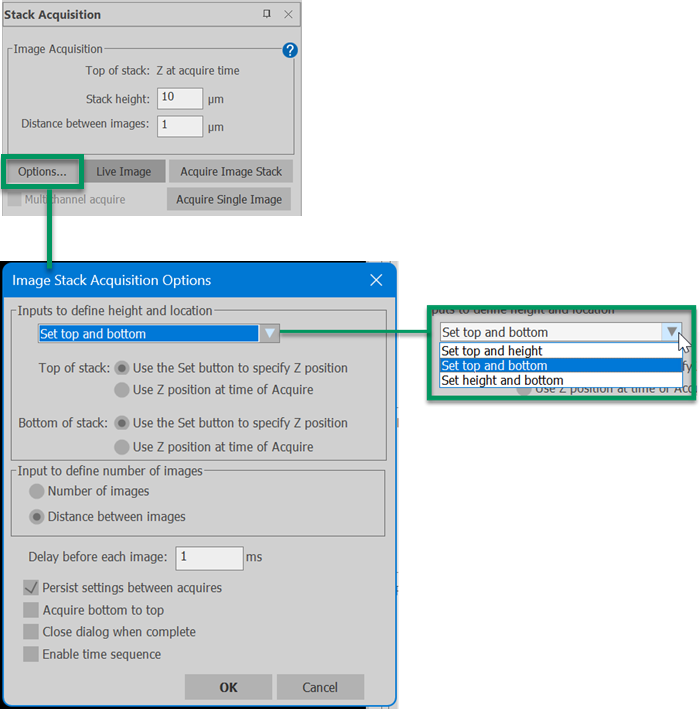Acquire an image stack
Purpose

|
Acquire an image stack from the current field of view. This creates a single image file comprised of a series of stacked image planes that represent z-planes of the specimen. |
See also Image Stack overview
Procedure
-
 Click Image Stack on the Acquire ribbon.
Click Image Stack on the Acquire ribbon.
The Stack acquisition panel opens.
-
Review the image-acquisition parameter choices and, if they suit your needs, enter your preferred settings as described in step 3 below.
-
-
Click Options... to change the choices in the Stack acquisition panel; this opens the Image Stack Acquisition Options dialog.
When options are changed here, they are reflected in the Stack Acquisition panel.
-
Inputs to define height and location:
-
Choose from the drop-down menu how you want to set the top and bottom image planes for the image stack.
-
Top of stack / Bottom of stack: choose how you want to identify the top/bottom of the image stack to acquire:
-
Use the Set button to specify Z position: Set the Z position dynamically
-
Use Z position at time of acquire: Use the current Z position when you click Acquire Image Stack
-
-
-
Input to define number of images: Choose whether to specify the number of image planes you want to capture or the distance between image planes.
-
Other options:
-
Delay before each image: The time allowed for the stage to settle after a Z move. If there is evidence of motion in the images, try increasing the time delay to 200 ms.
-
Persist settings between acquires: the selections will be the default for the user profile until they are changed.
-
Acquire bottom to top: Changes the default image stack acquisition behavior from top to bottom to the opposite when checked.
-
-
Click OK when option changes are complete or Cancel to leave the options unchanged.
-
-
Make sure you are in Live Image mode, with the camera feed showing on screen. Click Live Image in the Stack acquisition panel or
 on the Acquire ribbon.
on the Acquire ribbon. -
Input your settings in the Stack acquisition panel.
Note that the choices displayed in the Stack acquisition panel reflect the options selected.
-
Top/Bottom of stack: Z at acquire time—Position the sample top/bottom where you want it for image acquisition.
-
Top/Bottom of stack: <Not Set>—Click Set and move the stage to set the Z position for the top/bottom of the stack as desired.
-
Stack Height: Specify the height in µm for the image stack(s) to acquire.
-
Distance between images: Specify the distance in µm between image planes in the stack. Note that this value must be greater than the z-resolving power of the microscope.
-
Multichannel acquire: Check the box to acquire image stacks from multiple color channels as defined in the Multichannel control panel.
-
-
(optional) Click Acquire single image to test your settings on a single-plane image before collecting the entire stack.
Capture your image stack:
Acquire Image Stack: Click to begin the image stack capture; the following will happen:
-
BrightSLICE displays the image you've just acquired onscreen (Show Images mode).
- The image you just acquired is added to the Image Organizer as an unsaved image.
-